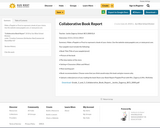
Make a Popplet or Prezi to represent a book of your choice. Use the
website www.popplet.com, or www.prezi.com.
- Subject:
- English Language Arts
- Material Type:
- Activity/Lab
- Date Added:
- 06/22/2018

Make a Popplet or Prezi to represent a book of your choice. Use the
website www.popplet.com, or www.prezi.com.
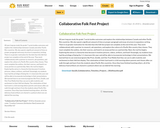
All year long we study the grade 7 social studies outcomes and explore the relationships between Canada and other Pacific Rim countries. We also spend a significant amount of time on proper paragraph and essay structure in expository writing. There is no greater motivation for the kids than this folk fest project we complete at the end of the year. They work collaboratively with a partner to research, ask questions, and explore the culture of a Pacific Rim country they choose. They must complete the outline, cite their sources, and hand in an essay portion as a partnership. Next, the real fun begins. Exploring the extras is a favourite time because it involves pictures, videos, artifacts, and food! Amazingly, my students have had the privilege of being the 1:1 classroom this year and will be able to incorporate technology in their presentations. We learned how to use several programs like Prezi, Zondle, and One True Media that they can use to add creativity and excitement to their folk fest display. The culmination of their hard work is a full morning where parents and classes alike can walk through and learn from the students about Pacific Rim countries. Once they have finished teaching others, all of the delicious food artifacts are shared in a potluck where we can debrief the morning.
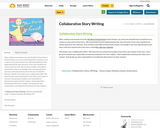
After reading several books from the My Weird School Series by Dan Gutman, my classroom decided that it would be fun to create our own weird school story. We had decided from the beginning that the main character of our story would be our colony supervisor, Mrs. Barclay. Since all titles in the Weird School Series rhyme, we thought it was only appropriate to also have a title that rhymed and so the class created Mrs. Barclay is Sparkly.
This project was a collaborative effort. We knew that we wanted each grade to have their own chapter in the story. Each group of students was responsible for brainstorming ideas for their chapter. I then helped them develop their ideas into a chapter. Each grade was also responsible for providing the illustrations for their chapters.
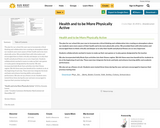
The plan for our school this year was to incorporate critical thinking and collaboration into creating an atmosphere where our students were more aware of their health and to be more physically active. We provided them with information and encouraged them to think critically and deeper as to why their health and physical fitness are so very important.
Students collaboratively worked in teams to make up their own games or to play games designated by the teacher.
We also incorporated daily Brain Gym activities into their fitness regime. We felt these exercises beneficial for students to do at the beginning of each day. These exercises integrate the brain and body and enhance learning ability and academic performance.
We also set up a fitness circuit. Students were tested three times during the year and were encouraged to improve their previous testing time
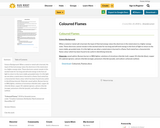
Science Background:
When a metal or metal salt is burned, the input of thermal energy raises the electrons in the metal atom to a higher energy state. These electrons cannot remain in this excited state for too long and will emit energy in the form of light to return to the more stable, grounded state. It is this light we see when a metal atom is burned in a flame. Each metal has a characteristic flame colour which has been found to be useful in identifying minerals.
Materials: wood splints, Bunsen burner or BBQ lighter, solutions of strontium chloride (red), cupper (II) chloride (blue), copper (II) sulphate (green), calcium chloride (orange), potassium chloride (purple), and sodium carbonate (yellow).
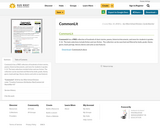
CommonLit has a FREE collection of hundreds of short stories, poems, historical documents, and more for students in grades 5-12. The texts selections include fiction and non-fiction. The collection can be searched and filtered by lexile, grade, theme, genre, book pairings, literary device and units (a new feature).
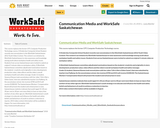
This course replaces the former CPT; Computer Production Technology course.
A Kindersley Composite School Student recently won second place in the WorkSafe Saskatchewan 2012 Youth Video Contest. The contest is an initiative by WorkSafe Saskatchewan to raise awareness and knowledge among youth about workplace health and safety issues. Students from across Saskatchewan were invited to submit an original 3-minute video on workplace safety.
A WorkSafe Saskatchewan committee adjudicated nominations based on the students’ creativity and originality in story development, production value, video effects and the video’s overall workplace health and safety message.
Grade 12 student, Vanessa Klassen took second place with her video “Life is Not a Video Game”, that was submitted by teacher Lisa Padberg. As the second place winner she receives $700 and KCS will receive $1000.00. The Saskatchewan Workers’ Compensation Board will present the student and school prizes in June.
Saskatchewan statistics indicate that youth (aged 15-24) are 20 per cent to 30 per cent more likely to have an injury than workers of any other age are. WorkSafe Saskatchewan’s youth strategy is to educate and influence the health and safety beliefs and behaviours of youth to achieve a reduction in injuries.
2013 video contest information will be available in August.
For more information, visit: http://www.worksafesask.ca/
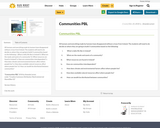
All humans and everything made by humans have disappeared without a trace from Ireland. The students will need to do decide on where they are going to build 3 communities based on the following:
i. What is daily life like in Ireland?
ii. What are the needs and wants of a community?
iii. What resources are found in Ireland?
iv. How are communities interdependent?
v. How does climate and environmental factors affect where people live?
vi. How does available natural resources affect where people live?
vii. How can wealth be distributed between communities?
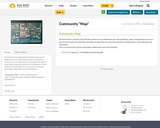
My Action Plan is related to Social Studies and the use of collaboration and critical thinking. I plan to evaluate the resources I am currently using in Social Studies and adjust or adapt them to move in the direction of collaboration, critical thinking, and technology.
This is an activity that involves technology, collaboration and critical thinking.
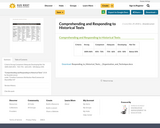
Criteria Strong Competent Adequate Developing Not Yet
100%-86% 85% - 76% 75% - 66% 65% - 50% Below 50%

The Comprehensive Demonstration of Learning (CDL) is a full semester project
where the students showcase their learning over the term in the form of a Google
site or blog. At the beginning of the CDL project, the criteria are co-created by the
students and myself. Students then need to demonstrate how they achieved or met
the outcomes in the course. Students’ then check in periodically over the course of
the term to discuss how the CDL process is going and I provide feedback on the
submissions to their CDL’s.
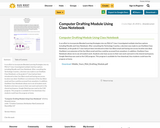
In an effort to incorporate Blended Learning Strategies into my PAA 6/7 class I investigated multiple interface options including Moodle and Class Notebook. After consulting the Technology Coaches, a decision was made to use OneNote Class Notebook, as the grade 6/7 class had just been introduced to their Sun West email and having one access location was ideal. OneNote is an extension of the Sun West email and thus could be accessed from anywhere. In addition, OneNote Class Notebook allows me to see all student work. Students only have access to their own work and work in the shared workspaces. Google Sketchup was used as the CAD program. This program is available for free download, thus students could have the program at home.
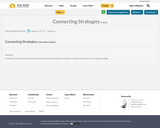
A variety of student activities and teacher resources for using the concept of 'making connections' as a reading strategy.
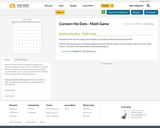
Directions for this age old strategy game that gets your students thinking creatively and critically:
With your friend(s) take turns making line segments to connect the dots. When you can complete a square, put your initial inside it. The winner is the person with the most initialed squares.
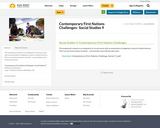
This assignment is based on an integration of current events with an examination of indigenous cultures in North America. There are two final products involved – a presentation and a fullclass discussion.

Science Background:
Encourage students to be creative in their problem-solving strategies, within the scope of the rules. Students will discover that any strategy that increases the amount of heat or increases the surface area of the ice will result in a faster melt. You might ask students how they would change their strategies if the ice cube were doubled in size, if they were melting a large block of ice, or if they were melting an equal mass of ice chips.
Materials: one ice cube for each student
Directions:
Melt an ice cube as fast as you can, using the following three rules:
1. You cannot put the ice cube in your mouth
2. You must collect as much of the melted water as possible (decide how you will collect the water)
3. You can only use what is at your desk right now
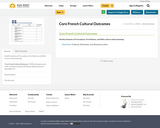
Identify elements of Francophone, First Nations, and Métis cultures with prompting.
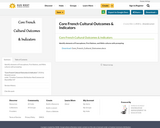
Identify elements of Francophone, First Nations, and Métis cultures with prompting
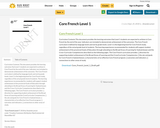
Curriculum Contents
This document provides the learning outcomes that Level 1 students are expected to achieve in Core
French by the end of the year. Indicators are included to demonstrate achievement of the outcomes.
The Core French curriculum is defined by language levels and not by grade levels. Level 1 is the
beginning level for Core French study, regardless of the actual grade level of students.
The learning experiences recommended for students will support student achievement of the
provincial Goals of Education through attending to the Broad Areas of Learning for Saskatchewan
and the Cross-Curricular Competencies described on the following pages.
The Core French curriculum provides:
direction for supporting student achievement of the Broad Areas of Learning and the CrossCurricular
Competencies;
the aim and goals for Core French in Saskatchewan;
characteristics of an effective Core French program;
outcomes and indicators;
connections to other areas of study.
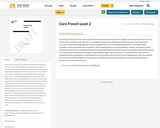
Curriculum Contents
This document provides the learning outcomes that Level 2 students are expected to achieve in Core
French by the end of the year. Indicators are included to demonstrate achievement of the outcomes.
The Core French curriculum is defined by language levels and not by grade levels. Level 1 is the
beginning level for Core French study, regardless of the actual grade level of students.
The learning experiences recommended for students will support student achievement of the
provincial Goals of Education through attending to the Broad Areas of Learning for Saskatchewan
and the Cross-Curricular Competencies described on the following pages.
The Core French curriculum provides:
direction for supporting student achievement of the Broad Areas of Learning and the CrossCurricular
Competencies;
the aim and goals for Core French in Saskatchewan;
characteristics of an effective Core French program;
outcomes and indicators;
connections to other areas of study.